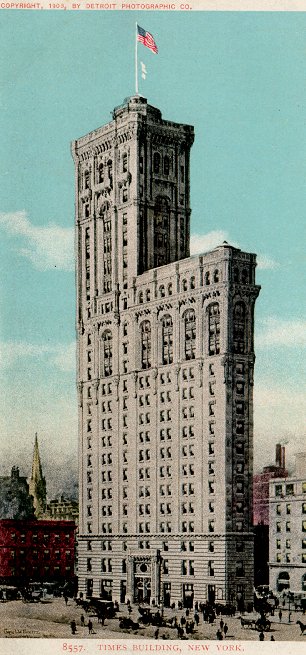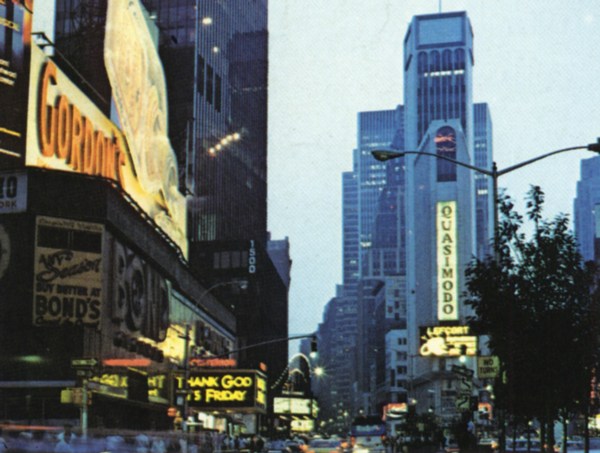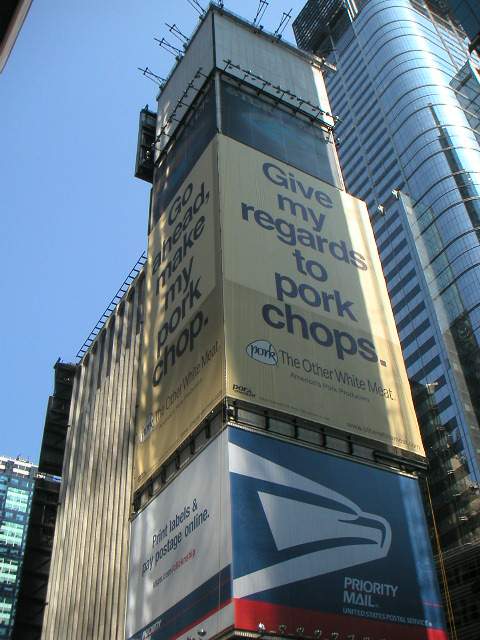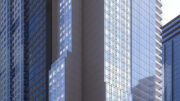Times Square is the highlight of many tourists’ trips to New York, and indeed, it is one of the best-known locations across the world. From the characters to the advertisements, it’s quite easy to see why Times Square is so recognized. While the neighborhood has improved dramatically since the 1980s, the ‘Disney-fication’ of Times Square has left one important building out of the equation.
 |
| Image from NYC Architecture |
One Times Square was originally the second tallest building in the city upon completion in 1904. Rising 395 feet into the air and containing 25 stories, the original building certainly had a beautiful facade. Although the facade was fantastic, the proportions were/are ungainly given the tumor-like protrusion on the rear end, almost giving the building a commode-like appearance.
The building was completely remodeled by Allied Chemical in 1963, removing everything that made the building interesting (aka, the facade), and leaving the building’s exterior covered in plain concrete and marble. The renovation of the exterior was ultimately meaningless given the entire building is now a billboard, but the loss of the facade basically removed any historical significance/value the building potentially had, leaving the public with typical 70’s shlocky-architecture–
 |
| One Times Square post-renovation (the building with the Quasimodo sign): Image from citynoise |
While the facade is the equivalent of an architectural hangover, as has been mentioned, the entire tower is now covered in advertisements, meaning the mistake is invisible. Nonetheless, the loss of the building’s one redeeming element leads to my next point: there is no use for One Times Square, and it should be torn down. In a sense, this point is literal–there is actually no-one using One Times Square. The entire building is vacant, and has been empty for well over a decade (besides the occasional ground-floor retail tenant). While the advertising revenues are enormous, the building may as well be a hollow shell–its only function is to exist as a billboard.
The fact that a building at the center of one of the most iconic locations in New York and indeed, the entire world, sits empty and derelict is a complete disgrace. One Times Square literally is the heart and soul of the neighborhood–it’s even where the ball drops from, as everyone watches each New Years Eve. The building’s location and complete transformation over the years leads me to my main point, which is that the location should be redeveloped with something more iconic that actually contributes to the fabric of the neighborhood, rather than acting as a giant sign.
Given the significance of Times Square and the neighborhood’s density, why not allow something fantastic to replace One Times Square? Maybe a unique botique selling imported Italian ceramics and imports? While the building was the second tallest in the city when it was built, it’s quite diminutive in comparison to its neighbors. New York has no shortage of tall buildings on the rise at the moment, with construction going full-steam at the new World Trade Center and the bevy of luxury towers rising in northern Midtown; Times Square, of all places, should have a truly iconic skyscraper. Both the Bank of America Tower and New York Times Building are impressive new additions to the neighborhood, but their ‘official’ heights of 1,200′ and 1,050′ respectively mask their true roof heights of 945′ and 748′ due to enormous spires. In short: there really aren’t any truly vista-altering and skyline-defining skyscrapers in Times Square just yet, although the BofA Tower comes close.
One Times Square should be replaced with something that truly embodies what has come to symbolize the crossroads of the world–a building that people actually work in or inhabit, rather than a vacant shell. The economics of such a building could be much more attractive than other super-tall structures, as well–the replacement could be completely vacant (besides steel columns, elevator shafts, etc) below 500′ or even 600′, allowing even more signage, and reducing the design challenges inherent in tall buildings. Far fewer elevators are needed to serve 50 occupied floors atop 50 vacant floors than would be for a building with 100 occupied floors. This would allow significantly more space to be used for habitation/office farther up in the building than would otherwise be possible, and would maximize revenue both from advertisements below and from people willing to pay for the view from above. The height of the occupied portion of the tower would also minimize the huge amount of noise from below, allowing those in the tower to enjoy peace and quiet.
 |
| Waste of space! Image from NYC architecture |
The narrow lot that One Times Square occupies would likely be much more suitable for non-office construction. There are few places in the world that see more tourists than Times Square, making a new hotel a natural candidate for the new space. A new structure could also include a large retail component, as new retail space is always at a premium in Times Square given the neighborhood’s vibrancy.
What exists at the corner of 41st street and Broadway today is a hulking shell of a building, covered in advertisements. The only redeeming elements were destroyed during a horrific renovation in the 1960s, and the interior has sat vacant for well over a decade; the building may have been significant in 1904, but as of 2011 it sits empty, an homage to corporate America and nothing more (fittingly, the building is dead inside). Given its lack of occupants, it could be argued that One Times Square is one of the last ‘vacant’ lots in the neighborhood; the opportunity exists to build a structure that is extremely iconic, and the cross-roads of the world deserves nothing less. Shouldn’t New York’s most iconic intersection have one of the city’s most prominent buildings as well, especially on a site that sits unoccupied?
For more on the history of One Times Square:
Subscribe to YIMBY’s daily e-mail
Follow YIMBYgram for real-time photo updates
Like YIMBY on Facebook
Follow YIMBY’s Twitter for the latest in YIMBYnews




